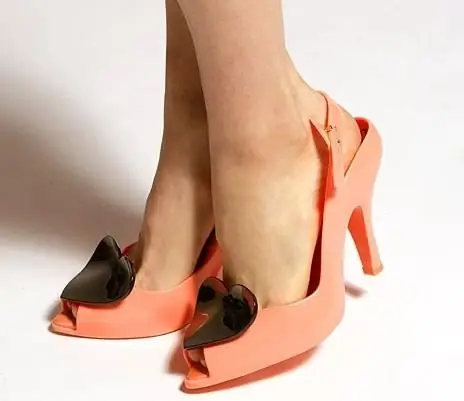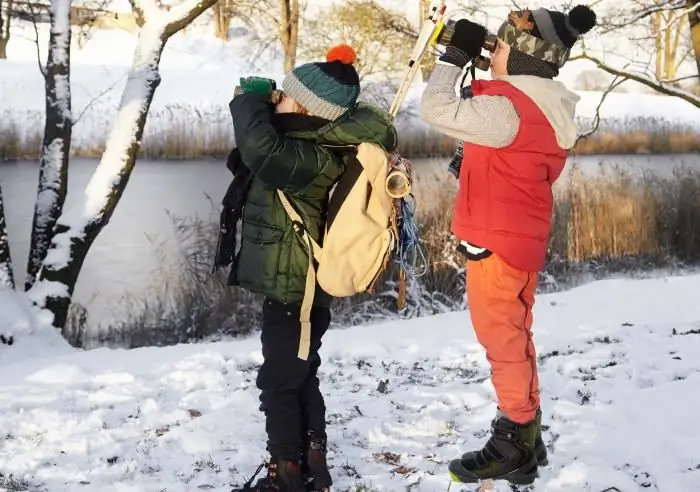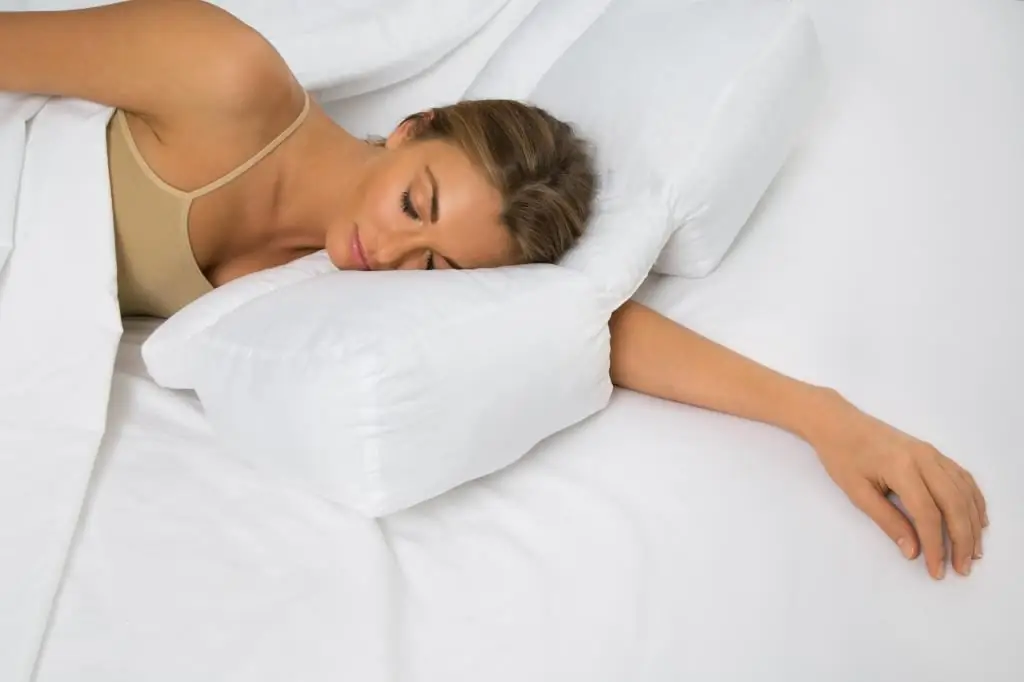2026 Author: Priscilla Miln | [email protected]. Last modified: 2025-06-01 05:14:29
Clubfoot is a common defect of the musculoskeletal system, which is expressed in the wrong position of the foot, while children are simply not able to put the foot on the floor correctly. The origin of this disease is not yet fully understood, but scientists have proven that girls have 50% fewer cases of the disease than boys.
The article will discuss such a phenomenon as clubfoot in children, the symptoms and methods of treatment. Parents whose child suffers from this pathology will learn what exercises to do with him, how to help him at home, what shoes their baby should wear, whether it is worth fighting this disease at all.
Classification of clubfoot
Clubfoot in children can be bilateral or unilateral, acquired or congenital, atypical or typical.
Main characteristics of all kindsclubfoot.
The typical form develops due to a defect in the development of muscles, ligaments and tendons. This anomaly does not extend beyond the foot. It is divided into 3 types:
- Varus deformity - characterized by a mild course of the disease and can be treated with a manual type of correction.
- Soft tissue - develops soft tissue resistance with manual correction.
- Bone - a very rare deformity, consists in persistent deformation of the bones of the foot and changes in the soft tissues, the work of the joint is limited. This type of deformity is not amenable to traditional treatment.

Atypical type of clubfoot in children occurs due to disorders of the musculoskeletal system (arthrogryposis, dysostosis, osteochondrodysplasia, ecromelia and others).
According to the degree of development of the disease, they are distinguished:
- Mild clubfoot - responds well to treatment, movement in the ankle joint is preserved.
- Medium - movement in the joint is limited, difficult to treat.
- Severe - needs surgery.
Congenital clubfoot can be detected as early as the 16th week of pregnancy with an ultrasound. But the final diagnosis is made after the birth of the child. There are several reasons for the development of such a pathology:
- Mechanical causes - arose due to strong pressure on the baby's feet of the walls of the uterus. Occurs when the fetus is in the wrong position or oligohydramnios.
- Genetic causes - arise due to hereditary diseases, in addition,the likelihood of this defect in a child increases if there are cases of clubfoot in relatives in the family.
- Neuromuscular causes - occur in the pathology of fetal development: deficiency of nerve fibers, improper development of ligaments and muscles (occurs at the 8-12th week of pregnancy), beriberi, pathology of pregnancy, bad habits of the mother during pregnancy.

Acquired clubfoot is a violation of the correct setting of the feet in absolutely he althy children, it begins to appear at the age of one to 3 years, the following symptoms gradually develop:
- Bear gait - the child paddles with one leg.
- Low ankle mobility.
- He puts his feet wrong, clearly visible from the footprints in the wet sand or snow.
- Knees turned inward.
Causes of acquired clubfoot:
- nervous system disorders;
- underdevelopment of bones;
- improper fusion of the bones of the lower leg and foot;
- rickets;
- leg injury;
- wrong shoes;
- polio.
Clubfoot begins to manifest itself due to the increasing load on the baby's legs, when he gains weight, his bones grow, and the muscles and tendons do not keep up with them. Many muscle groups are in good shape, while others, on the contrary, are relaxed. This is manifested in the deformity of the feet.
Symptoms
As a rule, clubfoot does not cause pain, but with the growth and development of the child it intensifiesdiscomfort and limited ability to walk. This disease does not go away on its own. The untreated foot remains twisted and may grow shorter and smaller than a he althy foot. As the child grows, the symptoms become more pronounced, he cannot fully play with his peers, there are big problems with the selection of shoes.
Complications
Parents should not let the disease take its course, hoping that everything will pass with age. Clubfoot in children is accompanied by flat feet and scoliosis, in addition, the neglect of the disease can lead to such complications:
- subluxation of foot bones;
- impaired functioning of the knee joints;
- muscle atrophy;
- disability.
A child who received timely assistance is no different from his peers after 5 years. They play any sport, their legs are as strong and mobile as the rest of the kids.
But if the clubfoot is not treated, the disease will begin to progress. Small children, of course, will adapt to walk and run, but after adolescence, they develop serious problems that can lead to disability.
How to get rid of this disease
How to cure clubfoot in a child, how to detect it? Clubfoot, if it is pronounced, can be detected immediately after the birth of the baby. Minor or hidden deformation can be noticed only after the child begins to walk. Treatment must begin as early as possible. Only an integrated approach can give a positiveresult.
- With pronounced clubfoot in young children, their legs are plastered in the form of boots that hold the foot in a normal natural position. Before starting the procedure, the legs are thoroughly kneaded, after which they are plastered to the knee, fixing them in the correct position. In such boots, the baby walks for about a week, after which they are removed, the legs are kneaded and plastered again for 2 weeks. This continues until the feet are in the correct position.
- When the baby begins to walk independently, he must wear orthopedic shoes. It is very stiff and uncomfortable, but helps to keep the foot in the correct position.
- Good for clubfoot in children foot massage. It consists of kneading the tendons in the right places.
- To warm up the muscles before the massage, physiological procedures are prescribed: electrophoresis, paraffin heating.
- For the treatment of clubfoot in a child 6 years of age and older, you can use a set of exercises that should be done several times a day. The most effective is rolling the rolling pin with your feet, walking on your toes.
- In some difficult cases, drug treatment is prescribed, usually drugs that improve the neurological condition.

Basic principles for successfully correcting clubfoot in children:
- constant monitoring by an orthopedist;
- early start of treatment;
- patience and perseverance of parents.
All methods of treating an ailment are aimed not only at correctingdevelopmental anomalies, but also to consolidate the results.
Treatment of congenital clubfoot
How to cure clubfoot in a child if it is congenital? This diagnosis is made in the hospital. You can start treatment in a week, it is usually carried out in a hospital under the supervision of an orthopedic doctor. The child's foot is fixed with a plaster cast. After the end of treatment (lasting about several months), a special splint is made for the child, which parents put on at night to avoid relapses.
Many orthopedists prefer the Vilensky technique. It is very effective for the treatment of clubfoot in a child of 1-5 years of age and in infants. With this type of therapy, the result is achieved much faster than with gypsum treatment. This is a comprehensive approach that includes:
- casting;
- orthopedic devices for fixing joints;
- massage;
- paraffin packs and physiotherapy;
- therapeutic gymnastics;
- baths with pine extract or medicinal herbs.
There are other methods of treating clubfoot, in addition to gypsum, using soft bandaging, applying a splint, as well as drug injections of Botox (it is injected under the skin into the calf muscle).
The method of treatment depends on the causes of development, the severity of the disease, the age and characteristics of the child's body.
Treatment of acquired clubfoot
How to treat clubfoot in a child if it is acquired? First of all, the cause of the disease should be established. Next, fixingmassage and a set of gymnastic exercises are prescribed. Usually the course of treatment takes from 2 to 5 months. The courses should be repeated until the clubfoot is eliminated. Sports recommended for children:
- dancing,
- swimming,
- snowboard, c
- kateboard,
- cycling.

If all methods of conservative treatment do not help and the disease progresses, then doctors perform a surgical operation.
Surgical treatment
Surgery for clubfoot in children is resorted to only when the foot does not take the correct position, despite all the measures taken. The tendons and ligaments of the foot joint are corrected by surgical intervention.
As a rule, congenital clubfoot is corrected when the child is 7-8 months old, because treatment must be completed before he can walk on his own.
Several methods are used, for example, N. N. Makov's method, Pansetti's method and others.
After the operation, the muscles of the foot become elastic and stiffer, the leg that was operated on often hurts, it is much weaker than a he althy foot.
Prevention measures
Such measures are necessary for both he althy children and those who got rid of clubfoot. Ground rules:
- You can't skimp on a child's shoes. Don't buy bigger shoes for him. When buying, you should pay attention to models that have a hard back, arch support and a clear fixation of the toe.
- Do not overwork the childlong walks, fatigue only exacerbates the problem.
- More often force the child to walk on uneven surfaces - stones, grass, asph alt, pebbles.
- Exercise regularly, the best sports for clubfoot are swimming, cycling, calisthenics or gymnastics.
Clubfoot Correction Plan
To fight clubfoot, you don't have to go to the gym, many exercises can be done at home. So, how to fix clubfoot in a child at home? Action Plan:
- It is necessary to develop a training scheme and gradually increase the load.
- Explain to the child what to do and how to do the exercises.
- Don't forget to praise and stimulate your baby.
- Perform all exercises together with the baby.
- Classes are best to start with a jog, this will warm up all the muscles well.
- Make sure that he puts his foot correctly during the run and all exercises.

Treatment of clubfoot in children at home consists in performing a series of exercises that will help overcome this pathology: walking on toes, squatting with goose step, muscle stretching exercises, rising on toes and falling back on the heels - "rifts", cycling.
As soon as the results become clear, you should take the child to any sports section to consolidate the result. In addition, you should always pay attention to the footprints of the baby, his gait andposture, he should have a complete he althy diet, which should include fish, cottage cheese, milk and dairy products.
Massage
Before you start doing foot massage for clubfoot in children, you need to buy literature and familiarize yourself with the rules and techniques. For example, Irina Krasikova's books "Children's Massage", "Flat Feet", which describe techniques and a number of exercises.

Massage should be aimed at kneading and stretching the tendons in certain places, as well as strengthening the muscles of the lower leg.
Orthopedic shoes
Orthopedic shoes for clubfoot in children are bought only in specialized stores. She must have:
- arch supports,
- hard backs,
- pads.

Orthopedic shoes should fully ensure the correct position of the foot, as well as be comfortable so that he wears them without problems. It should be borne in mind that only prolonged wear gives a good result.
Adult clubfoot
Treatment of an adult is practically no different from the treatment of a baby. But it will take more time, effort and patience, because his bones are already formed and are difficult to correct. It is very easy to diagnose such a pathology in yourself, just look at your shoes, if it is erased along the outer edge, then you should consult a doctor.
When treating clubfoot in an adult, the following rules must be observed:
- Wear orthopedic shoes. Women should not wear flats or heels. The right shoe is a heel that is about 2 centimeters high.
- Therapeutic exercise. You need to walk along the gymnastic stick up and down.
- Sports activities: swimming, running, cycling.
Advice to parents
If a child has a clubfoot, what should I do? All parents should know and remember that this disease is accompanied by such serious complications of the musculoskeletal system as scoliosis, flat feet. That is why you can’t let everything take its course and hope that this defect will pass by itself.
You must definitely consult an orthopedist, otherwise the disease will progress and, as a result, one leg may grow shorter than the other. And in the worst case, the child may become disabled.

Clubfoot must be got rid of, and this requires endurance and patience. But the reward will not keep you waiting, after all the efforts the baby's legs will become even and he althy, his gait will be light and beautiful.
It is much more difficult to get rid of this defect in adolescents and adults. But do not despair. An abundance of medical methods will help you succeed, you must follow all the doctor's recommendations and show diligence.
Recommended:
Orthopedic slippers. Home orthopedic shoes for women and children

After a hard day's work, fatigue appears, an unpleasant feeling of heaviness in the legs. Almost every person dreams of getting home as soon as possible and putting on their favorite slippers. Experts also pay attention to the fact that indoor shoes can be not only soft and comfortable, but also healing. Orthopedic slippers will bring significant benefits to the feet. Such shoes can be used for the treatment and prevention of many diseases
Orthopedic mat for a child. Orthopedic foot mat

In order for a child not to have flat feet, which in adulthood can cause unpleasant consequences and even serious diseases, care must be taken right from the moment of birth and especially actively when the child takes his first steps
Melissa shoes. Advantages and disadvantages of plastic shoes from Brazil

Shoes of different colors are always relevant in the arsenal of a person who follows the trends of modern fashion. Especially now, when an outfit consisting of clothes, shoes and accessories of the same color scheme is not too welcome. Another undoubted plus is the ability to look elegant in wet weather and at the same time not be afraid that expensive masterpieces from shoemakers who are on their feet will become unusable
The warmest winter shoes for kids. Reviews of winter shoes for children

Winter is coming, and the shelves with children's shoes are already full of a wide range of goods from various manufacturers. But despite the variety of types, models, colors, choosing the perfect winter option is a rather difficult task. What is the best quality and warmest winter shoes for children?
Rating of orthopedic pillows. How to choose an orthopedic pillow for sleeping?

Orthopedic pillow helps to take the correct position, which will provide a comfortable rest and evenly distribute the load on the musculoskeletal system. Such products are indispensable for injuries of the cervical spine and various diseases. But it is not easy to understand all the variety of the assortment. The rating of orthopedic pillows and product descriptions from trusted manufacturers will help you make the right choice

